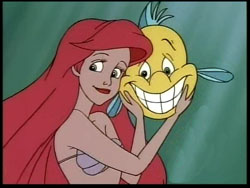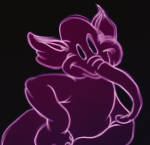The Little Mermaid on Television. In the September 10, 1992 issue of the Los Angeles Times, Jamie Mitchell, producer-director of Disneys television animated series The Little Mermaid said the following:

“I think it’s good that we’re addressing the girl audience because they’ve been underrepresented for such a long time. I don’t think maintaining the boy audience will be a problem. The stories have a natural action-adventure quality, and Sebastain is such a funny character that we never felt the gender of the audience would be an issue.
“I recognized that we would not be able to animate it as fully as the film, so I decided to put everything I had into the backgrounds, so you wouldn’t just be looking at the animation. I hired Ron Dias, whos a phenomenal background painter, as art director and he worked with Ed Ghertner, the layout supervisor on Beauty and the Beast (1991). The three of us got together and said, Let’s try to make the series look like an illustrated book, and focus on trying to get the backgrounds to play as much of a character role as the characters themselves.
“I liked the idea of setting the series prior to the film and not getting into a love interest issue. Our version of Ariel is a little younger, and the stories focus more on her relationship with her father and her family and the world. We concentrate on her wonderment at life and her interest in everything around her.”
More on Maggie’s First Word. In a December 1992 episode of The Simpsons, Maggie says her first word: “Daddy”. However there was much speculation as to what her first words might be.
 TV Guide magazine in its November 28, 1992 asked thirty-three celebrities what Maggie might say. Here is a short selection of those responses: Jim Carrey: “Spinoff?”, John Kricfalusi: “Happy, happy, joy, joy.”, Luke Perry: “MY show now.”, Bob Hope: “THIS is my family? Please, God, tell me I’m adopted.”, Bob Saget: “Whatever her first words are, they should be in old-world Yiddish.”, Tom Kenny: “I’ve been meaning to ask: Do I get a piece of the merchandising?”, Mayim Bialik: “Why did you keep that stupid pacifier in my mouth fo the past three seasons?” and Paul Rodriguez: “I’m going to Disneyland!”
TV Guide magazine in its November 28, 1992 asked thirty-three celebrities what Maggie might say. Here is a short selection of those responses: Jim Carrey: “Spinoff?”, John Kricfalusi: “Happy, happy, joy, joy.”, Luke Perry: “MY show now.”, Bob Hope: “THIS is my family? Please, God, tell me I’m adopted.”, Bob Saget: “Whatever her first words are, they should be in old-world Yiddish.”, Tom Kenny: “I’ve been meaning to ask: Do I get a piece of the merchandising?”, Mayim Bialik: “Why did you keep that stupid pacifier in my mouth fo the past three seasons?” and Paul Rodriguez: “I’m going to Disneyland!”
 Making Disney Sing Again. From the Boston Globe November 25, 1992 Jeffrey Katzenberg, then chairman of the Disney Studio said, “(Howard) Ashman and (Alan) Menken have taught us how to make our movies sing again which Hollywood has forgotten in the past thirty years. It’s a lost art that they brought back. In the last few decades, they were musical numbers but no true musicals. They did it not only with their choice of material but, just as importantly, by showing us how to use a song to advance the story, how to make them perfectly, seamlessly integrated to one another.”
Making Disney Sing Again. From the Boston Globe November 25, 1992 Jeffrey Katzenberg, then chairman of the Disney Studio said, “(Howard) Ashman and (Alan) Menken have taught us how to make our movies sing again which Hollywood has forgotten in the past thirty years. It’s a lost art that they brought back. In the last few decades, they were musical numbers but no true musicals. They did it not only with their choice of material but, just as importantly, by showing us how to use a song to advance the story, how to make them perfectly, seamlessly integrated to one another.”
 Ingenious Pink Elephants. Ken O’Connors design of the Pink Elephants sequence in Dumbo (1941) was much cleverer than many animation fans suspect. O’Connor developed a method by which characters were composed of changing color gradations. It was virtually impossible to achieve this effect by airbrushing the cels, because a consistent density from cel to cel could not be achieved.
Ingenious Pink Elephants. Ken O’Connors design of the Pink Elephants sequence in Dumbo (1941) was much cleverer than many animation fans suspect. O’Connor developed a method by which characters were composed of changing color gradations. It was virtually impossible to achieve this effect by airbrushing the cels, because a consistent density from cel to cel could not be achieved.
OConnor came up with a clever and simple solution. The color gradations of the Pink Elephants were painted on a background sheet and the elephants were left transparent areas on the cels placed over the background. The rest of the image on each cel was painted black. What appears to be the color of the Pink Elephants is actually the background, and what appears to be the black background is actually painted on the cels. The colors of the Pink Elephants appear to keep changing, without the need to duplicate color on each cel.
 Barbera on Tom and Jerry. In the Collector’s Advantage magazine for Winter 1992, animation producer Joe Barbera said, “We picked a cat and a mouse because when you see a cat and a mouse, you don’t have to worry about plot too much. The cats always after the mouse and the mouse has to survive. We also had one cardinal rule: the mouse never picked on the cat. So anyway, it went out and we got nominated for an Academy Award for the first cartoon. The thing that is incredible to me in the reaction around the world for Tom and Jerry. It’s incredible.”
Barbera on Tom and Jerry. In the Collector’s Advantage magazine for Winter 1992, animation producer Joe Barbera said, “We picked a cat and a mouse because when you see a cat and a mouse, you don’t have to worry about plot too much. The cats always after the mouse and the mouse has to survive. We also had one cardinal rule: the mouse never picked on the cat. So anyway, it went out and we got nominated for an Academy Award for the first cartoon. The thing that is incredible to me in the reaction around the world for Tom and Jerry. It’s incredible.”
Dirty Bob. Bob Godfrey was a British animator whose career spanned roughly fifty years. While he produced some highly popular childrens animation series during that time, he received his Academy Award nominations for the much more adult oriented Kama Sutra Rides Again (1971) and Dream Doll (1980). In fact, Kama Sutra Rides Again was personally selected by filmmaker Stanley Kubrick to be screened with the UK release of his feature film A Clockwork Orange (1971).
The cartoon features the stodiest of British couples who with enthusiasm go leaping from one acrobatic love pose to another. Dream Doll is the story of a timid man who buys a life sized inflatable sex doll and to his amazement, discovers that she has a will of her own and she escapes through a window and follows him to work. The story was inspired by the classic French film, The Red Balloon (1956).
Godfrey was also responsible for Henry 9 Till 5 (1970) where a dull office clerk voiced by Godfrey himself fantasizes outrageous sexual activities all day long and is too exhausted to satisfy his wife when he comes home. It was the first British animated cartoon to receive an “X” certificate. Henry even makes a cameo appeareance in Kama Sutra Rides Again, while Stanley and Ethel are having naked sex on an escalator in the London Underground. Godfrey later claimed that the character of Stanley was based on Stan Hayward who wrote the short.
In the same spirit, Godfrey made Bio Woman (1980) about a henpecked husband who adds too much detergent to the washing machine and creates a woman out of soap suds and Instant Sex (1980) where a man at a store sees a can labelled ‘Instant Sex’ and takes it home and gets a surprise and rushes back to buy as many cans as he can. Godfrey was also responsible for Wicked Willie (1990) based on a series of popular cartoon books about the adventures and conversations of a man and his “willie”, a British slang term for penis.


 Jim Korkis is an internationally respected animation historian who in recent years has devoted his attention to the many worlds of Disney. He was a columnist for a variety of animation magazines. With his former writing partner, John Cawley, he authored several animation related books including The Encyclopedia of Cartoon Superstars, How to Create Animation, Cartoon Confidential and Get Animated’s Animation Art Buyer’s Guide. He taught animation classes at the Disney Institute in Florida as well as instructing classes on acting and animation history for Disney Feature Animation: Florida.
Jim Korkis is an internationally respected animation historian who in recent years has devoted his attention to the many worlds of Disney. He was a columnist for a variety of animation magazines. With his former writing partner, John Cawley, he authored several animation related books including The Encyclopedia of Cartoon Superstars, How to Create Animation, Cartoon Confidential and Get Animated’s Animation Art Buyer’s Guide. He taught animation classes at the Disney Institute in Florida as well as instructing classes on acting and animation history for Disney Feature Animation: Florida.




















































I recalled that Saban produced thier own version of The Little Mermaid called Saban’s Adventures of the Little Mermaid around 1991 right on the heels of Disney’s blockbuster classic.
Saban’s was based on the Japanese anime “Ningyo Hime Marina no Bouke” (The Adventures of Mermaid Princess Marina), animated by Fuji Eight Co Ltd, which is not to be confused with the 1975 animated feature version of Hans Christian Andersen’s The Little Mermaid animated by Toei – which was further confusing because both Toei and Fuji Eight had the mermaid’s name as Marina. Saban, in their version, called her “Saban” instead of Marina.
The result? The series bombed. Disney’s TV version of The Little Mermaid lasted for two seasons – while Saban’s only lingered for one.
Uh… What children stuff did Bob Godfrey do? I kind of find it hard to believe about that after seeing his more erotic stuff.
He animated the iconic British animated series Roobarb, Noah and Nelly in…Sky/Ark and Henry’s Cat .
I love Bob’s work, I just wish more of it was online for us to view (especially Bio Woman).
I’m mainly familiar with Godfrey’s “The Many Deaths of Norman Spittal” shorts featured on MTV’s “Cartoon Sushi”.
I watched an episode of the Little Mermaid series for the first time in almost 25 years recently (I never watched it much in the first place) and the divide between the characters created and animated by the feature division for the original film and characters created by those in charge of churning out an ungodly amount of yearly half hour shows in that era is pretty drastic.
You know; I would believe that if I never watched TaleSpin once in my life. I didn’t see the difference of the Little Mermaid to be that drastic when the creators of TaleSpin made Baloo into a pilot, Louie into a bartender and Shere Khan into a CEO of a Fortune 500 company.